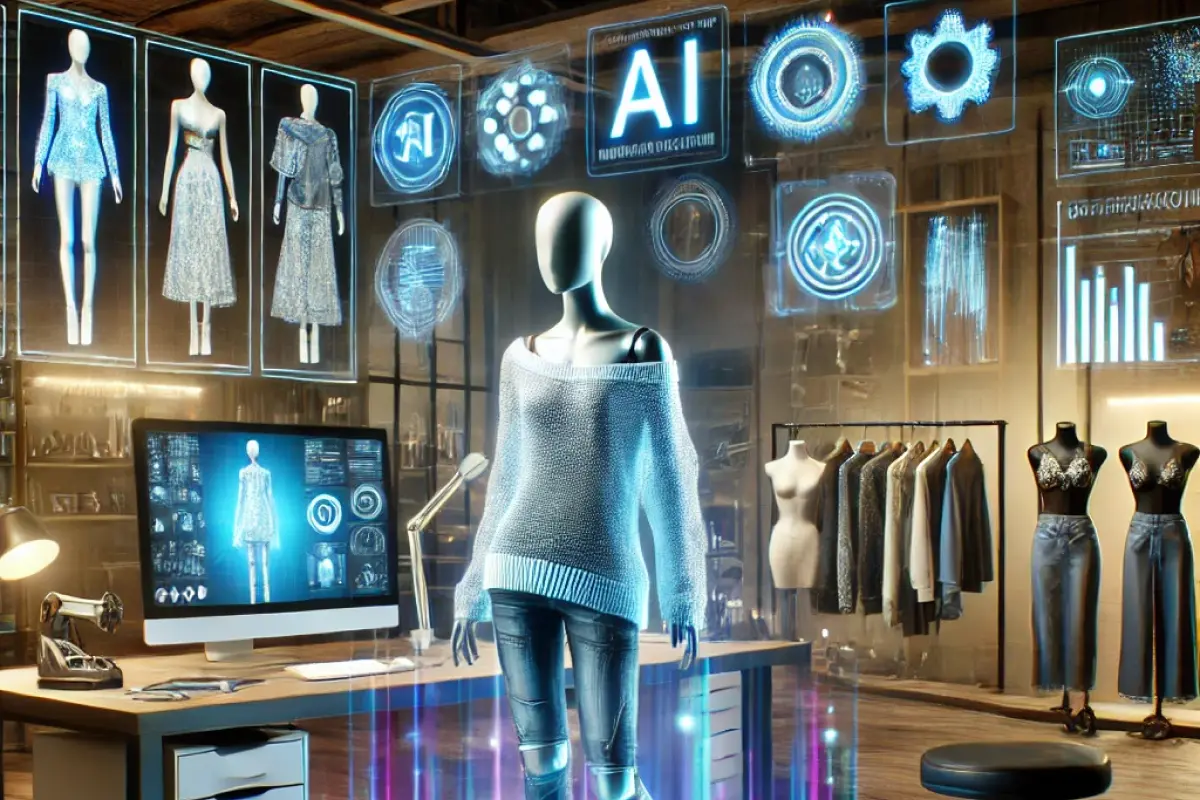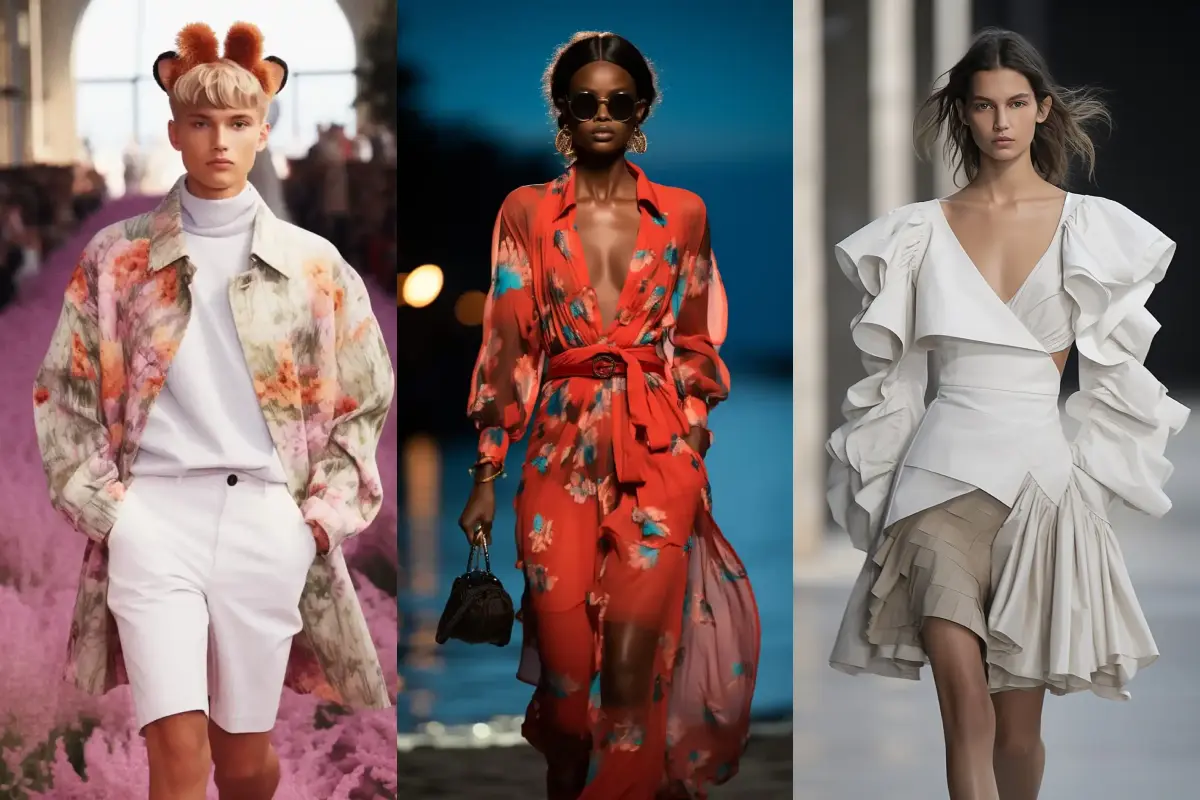
AI Apparel
The fashion industry is undergoing a remarkable transformation, thanks to the integration of artificial intelligence (AI). AI-driven clothing is not just a future idea. It is changing how fashion brands design, produce, and connect with customers. From creating designs to optimizing inventory, AI tools are revolutionizing every aspect of the fashion world.
How AI Apparel Is Changing Fashion Design
Fashion design has traditionally relied on creativity and manual effort. However, AI-driven tools are now empowering designers to save time and enhance creativity.
These powerful tools use natural language processing and image generation to produce innovative designs. Fashion brands can use AI to study what customers like. They can also predict trends and make collections that appeal to their audience.
AI-generated clothing designs enable faster prototyping and more accurate alignment with market demands. AI tools can look at past fashion data, current trends, and how people shop. They can suggest the best designs for future seasons. This data-driven approach allows fashion brands to stay ahead of competitors while reducing waste in the design process.
AI Clothing Brands, Personalization, and Brand Identity
Many AI clothing brands are using artificial intelligence to offer personalized shopping experiences. AI-driven systems analyze customer preferences, browsing history, and purchase behaviour to recommend products. These systems enhance customer satisfaction and drive higher conversion rates by tailoring product suggestions to individual tastes.
For instance, some AI-powered platforms can generate product descriptions that resonate with different customer segments. By leveraging natural language processing, brands can create compelling and accurate descriptions that boost online sales. Personalization doesn’t just enhance customer experience; it also fosters loyalty and repeat purchases.
AI in Trend Forecasting
Trend forecasting has always been crucial for fashion brands. With AI, predicting trends has become more accurate and efficient. AI tools analyze massive amounts of data from social media, fashion shows, and consumer feedback to identify emerging trends. This allows fashion brands to respond quickly and invest in apparel that aligns with market demands.
AI-driven trend forecasting helps brands reduce the risks associated with overproduction and underproduction. When brands understand what customers want, they can produce only what’s needed, which reduces waste and saves resources. This sustainable approach benefits both businesses and the environment.
Enhancing Inventory Management with AI
Inventory management is a critical challenge in the fashion industry. Overstocks and stockouts can lead to financial losses and unsatisfied customers. AI-powered systems optimize inventory management by predicting demand accurately. These systems analyze sales data, seasonal trends, and customer preferences to ensure the right products are available at the right time.
Fashion brands leveraging AI for inventory management can reduce waste and improve operational efficiency. For example, AI can help brands decide which items to restock, which to discontinue, and how to price products for maximum profitability. This data-driven approach makes inventory management more reliable and cost-effective.
Training AI for Fashion
Training AI for fashion is revolutionizing the way designers and brands create unique apparel. By simply uploading a photo or providing a text prompt, users can teach AI systems to recognize and generate distinctive style elements—such as patterns, colors, and textures—that reflect their brand identity and unique style.
This creative process allows designers to generate a wide variety of innovative designs in a fraction of the time it would take using traditional methods. With AI, users can focus more on high-level creative decisions, while the technology handles the rapid generation of new apparel creations. The result is a streamlined workflow that empowers users to create unique products that stand out in the market, providing endless opportunities to showcase individuality and creativity in every design.
Best AI Tools for Fashion Design
Fashion brands are investing in the best AI tools for fashion design to stay competitive. These tools assist in various stages of the design process, from conceptualization to production. Most AI apparel platforms require users to create an account, which serves as the primary access point for managing shared collections, collaborating with teams, and training AI models. AI-driven software can generate realistic 3D models of clothing, enabling designers to visualize their creations before production.
Some popular AI tools focus on image generation, which helps designers experiment with different patterns, fabrics, and colors. Others specialize in natural language processing to create detailed product descriptions or analyze customer feedback. By integrating these tools into their processes, fashion brands can innovate faster and more effectively.
AI-Driven Marketing and Customer Engagement
AI isn’t just transforming design and production; it’s also changing how fashion brands market their products. AI-driven systems analyze customer data to create targeted marketing campaigns. These campaigns enhance customer engagement by delivering personalized messages at the right time.
AI can help brands find the best platforms to reach their audience. It can also show the best time to launch campaigns. This targeted approach increases brand visibility and drives sales.
By using AI, brands can measure how well their campaigns are doing in real time. They can also make changes to improve results.
Reducing Waste with AI-Driven Apparel
Sustainability is a growing concern in the fashion industry, and AI-driven apparel offers solutions to reduce waste. AI tools help brands reduce waste. They do this by improving production processes, predicting demand accurately, and creating designs that satisfy customers. This reduces the likelihood of unsold inventory and unnecessary resource consumption.
Fashion brands can also use AI to repurpose excess inventory creatively. For example, AI systems can suggest ways to reuse unsold items. They can also locate markets that need these products. By adopting AI-driven strategies, brands contribute to a more sustainable and eco-friendly fashion industry.

AI Fashion Week Top 20 – fashionweek.ai
AI and Fashion Shows
Fashion shows are an essential part of the industry, showcasing new collections and setting trends. AI is transforming how these events are organized and experienced. AI tools can create realistic virtual models. This allows brands to hold digital fashion shows for a global audience.
Artificial intelligence also helps brands analyze audience feedback during and after fashion shows. This data provides insights into customer preferences, helping brands refine their collections. Virtual fashion shows powered by AI reduce costs and expand accessibility, making high fashion more inclusive.
AI Fashion Week – fashionweek.ai
Virtual Try-Ons and Models
Virtual try-ons and AI-generated models are transforming the way users interact with apparel designs. By leveraging AI to create realistic 3D models and simulations, designers can visualize their creations without the need for physical samples, saving valuable time and resources. Users can simply upload an image or provide a text description to generate virtual models that bring their designs to life, allowing them to perfect every detail before production. This technology also enhances the customer experience, enabling shoppers to see how products would look on them and confidently choose the perfect apparel. Virtual try-ons reduce returns and provide a creative, flexible way for users to explore and select from a wide range of virtual designs and products, making the entire process more efficient and engaging.
Collaboration and Teamwork in AI-Driven Fashion
Collaboration and teamwork are at the heart of AI-driven fashion innovation. Modern AI-powered platforms provide users with the ability to create team accounts, share data, and work together seamlessly on apparel designs. Each team member can contribute their unique style and expertise, helping to generate creative products and services that reflect a strong brand identity. By providing a collaborative environment, these platforms enable teams to generate, refine, and order perfect designs and products that meet customer needs. This approach not only streamlines the design process but also strengthens the brand’s reputation in a competitive market. By choosing to work together and harnessing the power of AI, fashion professionals can create high-quality apparel and services that truly stand out, providing customers with innovative and unique creations every time.
The Future of AI-Driven Apparel
The integration of AI in the fashion industry is still evolving, but its impact is undeniable. AI clothing brands are setting new standards for innovation, efficiency, and sustainability. As AI tools become more advanced, they will continue to revolutionize the design process, inventory management, and customer engagement.
Fashion brands that embrace AI-driven solutions will be better positioned to adapt to changing market dynamics. By leveraging AI, these brands can save time, reduce waste, and enhance customer satisfaction. The future of fashion is in artificial intelligence. Those who invest in AI clothing now will lead the industry later.
In conclusion, AI is more than a strong tool. It is the key to opening new chances in the fashion industry. From designing trend-responsive collections to managing inventory efficiently, AI is reshaping how fashion brands operate.
As technology grows, the options for AI-driven clothing are endless. This offers exciting opportunities for designers, brands, and consumers.




